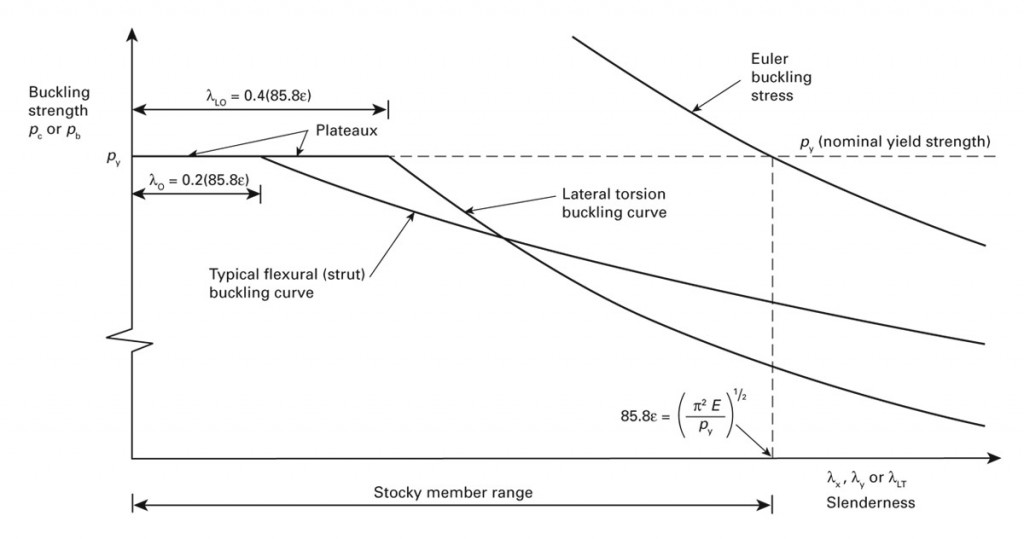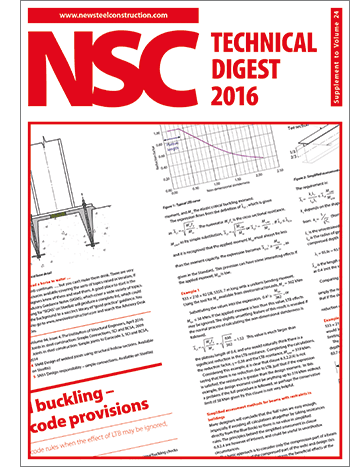Technical
AD 301: The use of Annex I1 of BS 5950 -1: 2000.
For Class 1 and 2 sections, Clause 4.8.3.1 allows the alternative of using Annex I1 to check the buckling resistance of compression members with moments instead of using the various equations in Clause 4.8.3.3. Annex I1 uses the plastic resistance of members in its buckling resistance checks and gives higher capacities for buckling of stocky members than would be obtained by using the equations in Clause 4.8.3.3.
Annex I1 has been implemented in various commercial softwares and Figure 1 shows the slenderness range for ‘stocky members’ where Annex I1 may be used to advantage. A combined plateau length λrO is determined in Annex I1 which takes into account the actual flexural and lateral torsional buckling effects on the member. In addition, a combination of the two buckling curves shown in Figure 1 is used in Annex I1.
The three conditions that need to be satisfied in order to use Annex I1 are as follows:
1. The member or segment must have a double symmetric cross-section over its entire length.
2. The member cross section must be classified under the action of applied moment(s) and axial load as either Class 1 plastic or Class 2 compact.
3. At least one of the relevant slenderness, λx , λy or λLT , of the member must be less than 85.8ε.
Annex I1 covers ‘stocky members’ and although no clear definition is given, when the above 3 conditions are satisfied, the member or its segments may be said to be stocky. If the cross-section is classified as either Class 3 or Class 4, Annex I1 may not be used to determine its resistance to buckling because these sections are incapable of developing plastic resistances.
The value of 85.8ε is the slenderness where the nominal yield strength (py) equals the Euler buckling stress, as shown in Figure 1. When the slenderness of a member or segment is greater than 85.8ε, the equations in Annex I1 revert to those in Clause 4.8.3.3 and no increase in capacity is gained. Careful reading of Annex I1 will show that it is acceptable for a member or segment to comply with the slenderness limit of 85.8ε about only one axis and to demonstrate increased capacity about this one axis alone.
Care should be exercised in interpreting the results of an Annex I1 buckling check in comparison to a clause 4.8.3.3 check and in particular to the simplified method in clause 4.8.3.3.1. It is not possible to directly compare the results or unity factors from an Annex I1 check and a clause 4.8.3.3 check.
Clause 4.8.1 states that ‘The buckling resistance of the member may be assumed to be unaffected by shear’ and therefore it is not necessary to determine whether the member is subject to low or high shear in order to apply either clause 4.8.3.3 or Annex I1.
Although Annex I1 uses the plastic resistance of members in its buckling resistances equations it should not be used to check the buckling of a segment in a member adjacent to a plastic hinge as a substitute for clauses 5.3.3, 5.3.4 or Annex G. Likewise, Annex I1 should not be used to check columns in simple construction as a substitute for clause 4.7.7.
Many questions have been asked concerning the different slenderness used in Annex I1. The calculation process starts with λx λy and λLT and these are clearly defined in the code. A combined slenderness λr , accounting for the actual flexural and lateral torsional buckling effects on the member or segment is determined, but this is not the same as λr in Section 5 concerned with in plane stability of continuous structures.
Compression members with moments must also satisfy a cross-section capacity check in accordance with clause 4.8.3.2. Clause 4.8.3.2 b) permits the alternative of using the ‘More exact method’ in clause 4.8.2.3 for Class 1 plastic or Class 2 compact sections. In cross-section capacity checks it is necessary to take account of high shear in calculating the resistance of members.












